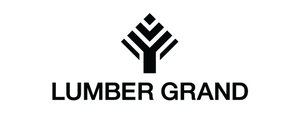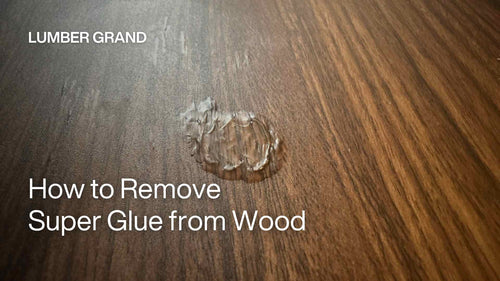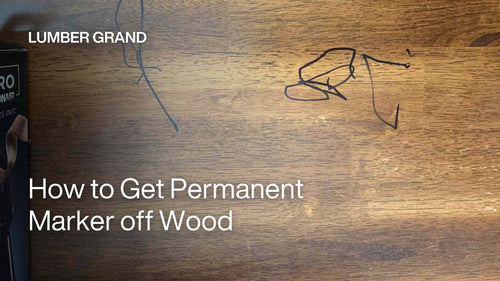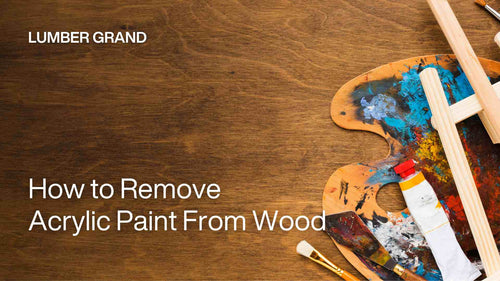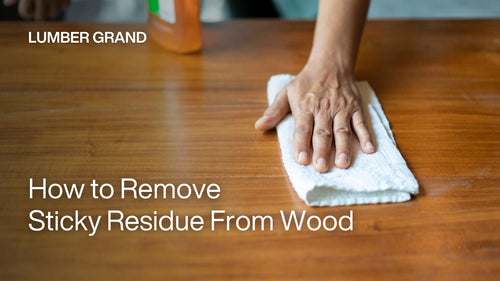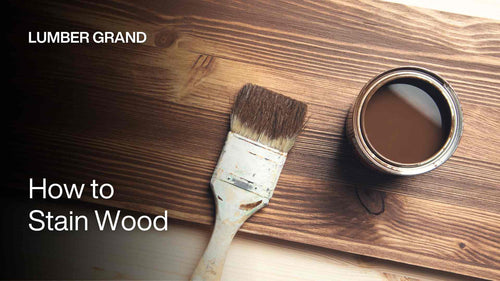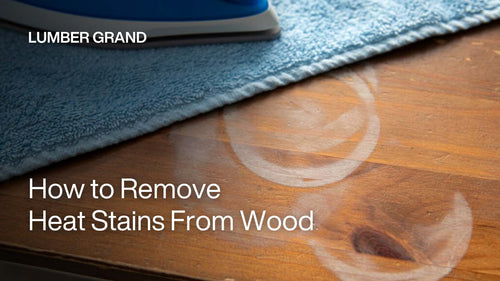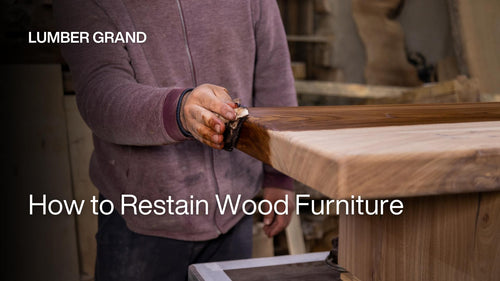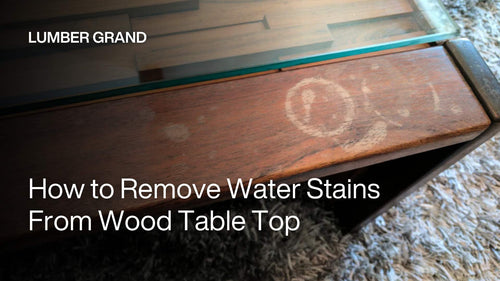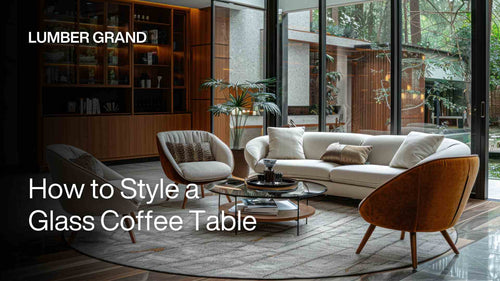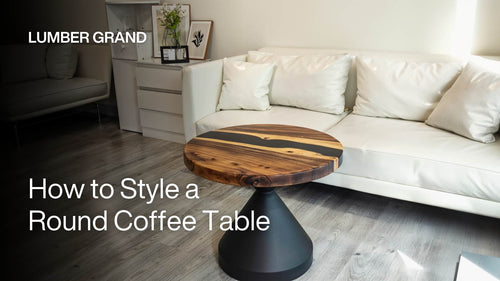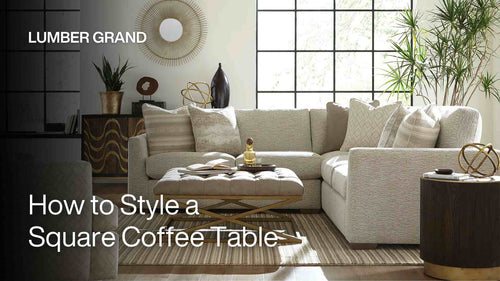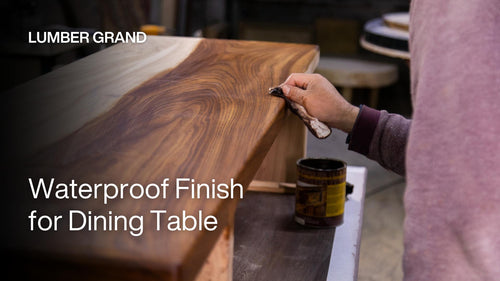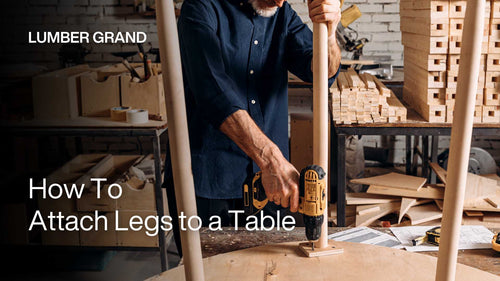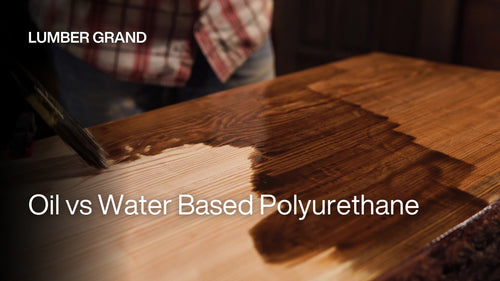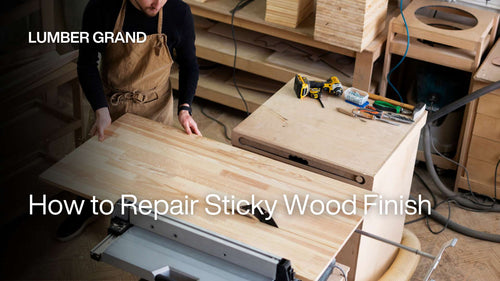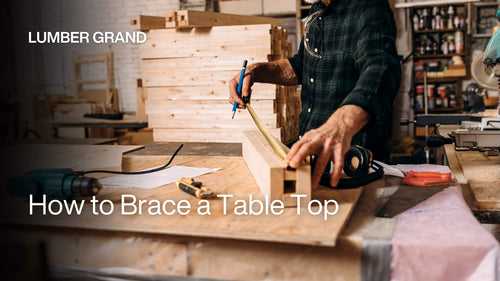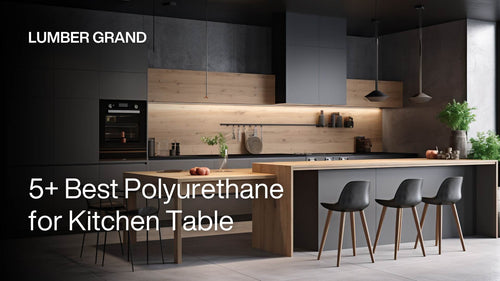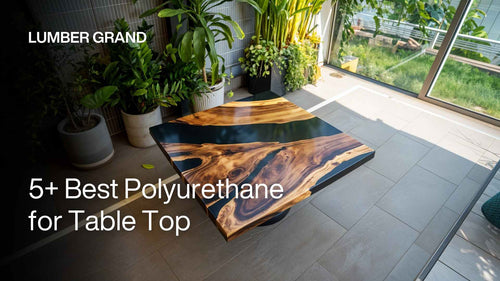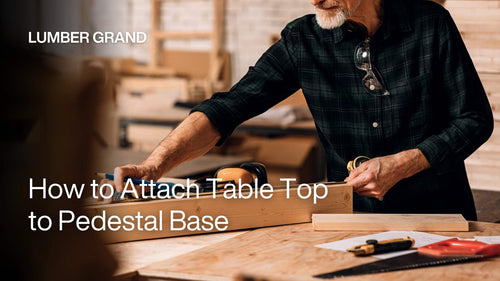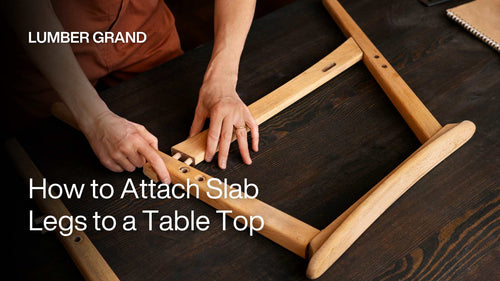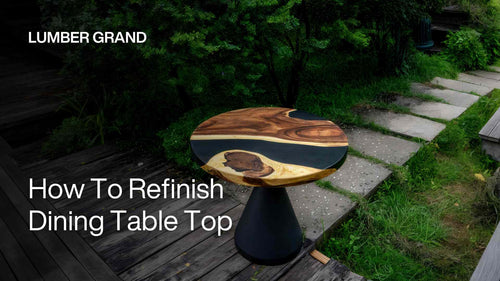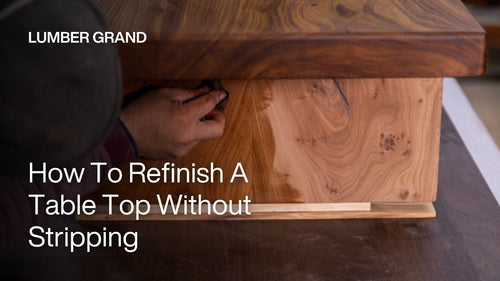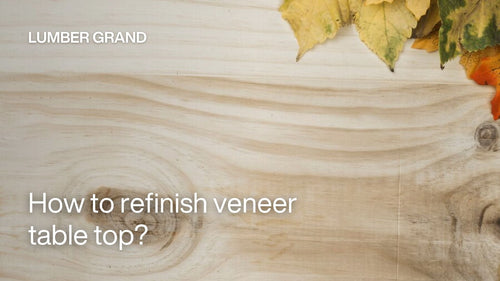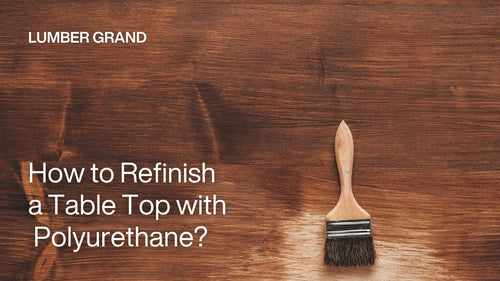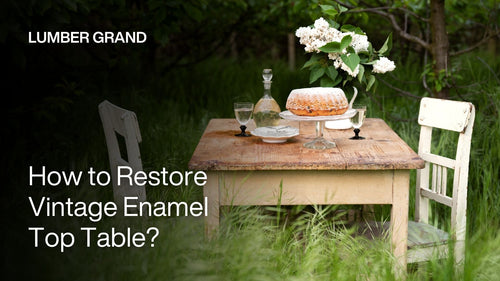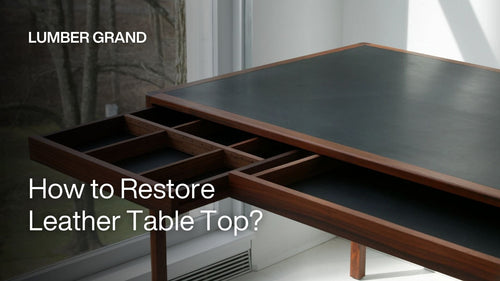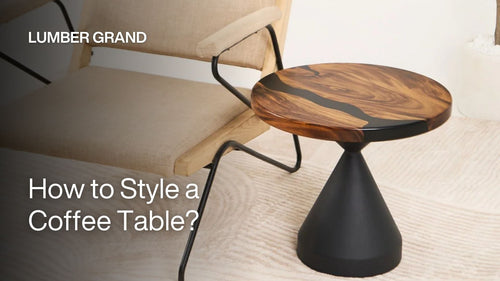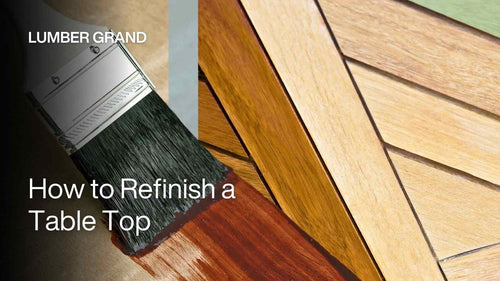How to epoxy a table top is the go-to solution for anyone who wants a durable and stylish table. It’s a little DIY project that’s easy to do and delivers a real wow effect from the first try.
But is learning how to epoxy resin a table top complicated? The answer is no, if you follow the proper steps. Lumber Grand has put together a 7-step guide for beginners to make things easier. Just follow along, and you can turn the table into a stunning centerpiece for your home. Read more!
How to Epoxy a Table Top: 7 Key Stages for a Crystal-Clear Finish
Ready to bring your table to life? No fancy skills are required here. Lumber Grand will walk you through 7 steps from prep to a flawless and crystal-clear finish.
Step 1. Gather Your Tools and Materials
A smooth project starts with good prep. So let’s grab everything you’ll need before we begin how to epoxy a table top and edges.
|
Tools and Materials |
Why You Need It |
|
Epoxy resin and hardener |
Pick a trusted brand like ArtResin or Pro-Marine Check the date to avoid yellowing or insufficient curing |
|
Painter's tape and non-stick tape |
Painter’s tape blocks drips and non-stick tape lines molds for easy release. |
|
Measuring cup and mixing bucket |
PP plastic or silicone buckets are ideal since they’re easy to clean. |
|
Rubbing alcohol |
90% or higher to clean surfaces for better bonding |
|
Sandpaper |
80 — 120 grit and 180 — 220 grit to smooth before pouring 120 — 320 grit to level flaws 220 — 320 grit for a matte finish 400 — 600 grit for a satin finish |
|
Brush |
Go with a soft, non-shedding brush to spread epoxy evenly |
|
Putty knife, or cutting knife |
Great for trimming edges, drips, or bubbles |
|
Hand saw |
A hand saw must adjust the tabletop shape or smooth out rough edges. |
|
Non-contact thermometer |
Monitor the room and resin temperature for proper curing |
|
Mixing stick |
Use sturdy wood/plastic to avoid splinters in resin |
|
Heat gun |
For popping bubbles. Should choose an adjustable heat to prevent scorching |
|
Gas mask and nitrile gloves |
Mask blocks fumes, and nitrile gloves protect hands |
|
Dust cloth |
Wipe the surface clean and dust-free before pouring |

How to make an epoxy resin table top tools
Photo: Freepik
Related blog: How to Make an Epoxy Table
Step 2. Prep the Surface Before Pouring Epoxy
With your tools ready, it’s time to get the table top in shape. Wipe it down with a soft cloth and a little mild soap to clear away any dust or dirt. Small particles can ruin the clarity of your finish or keep the resin from sticking properly.
After that, give the surface a nice sanding to smooth out scratches and create the perfect base for your epoxy. Begin with a coarser grit (80 — 120) to smooth out scratches or remove any old finish. Then, we switch to a finer grit (180 — 220) for a nice, even surface.
Once that’s done, wipe everything clean again with a cloth and rubbing alcohol (90%+) to help the epoxy grip better
Note: Set up your project in a clean, dry, dust-free space so no particles sneak into your glossy finish

Prepping the surface carefully will help how to apply epoxy resin to a table top better
Photo: Freepik
Step 3. Mask and Secure the Edges
Securing the edges is the third step in making an epoxy resin table. We use painter’s tape around the sides of the table to keep the epoxy from dripping over. If you’re working with a mold or want to create a border for the epoxy, you can also add non-stick tape.
Don’t forget to place your table top flat so the epoxy spreads evenly without pooling to one side. We recommend laying paper or plastic underneath to catch any excess epoxy and prevent a mess.

Use tapes to secure the edges of the table top
Photo: Freepik
Read more: Epoxy Table for Beginners
Step 4. Calculate and Mix Epoxy
This key step directly affects how your epoxy table top turns out. That’s why we’ll break it down into smaller parts, so it’s easier for you to follow along.
1. Calculate the epoxy needed
You can measure and calculate the epoxy volume using this simple formula to determine how much epoxy you need.
|
Epoxy Volume = (Length × Width × Depth) - (Wood Area) |
For example, let’s say your table measures 36” x 18”, and you want the finished epoxy layer to be about 2” thick.
-
If you cover the entire surface with epoxy: 36 × 18 × 2 = 1,296 sq in ≈ 5.6 gallons epoxy
-
If you’re making a river table and leaving half the surface as wood (36” × 9”): (36 × 18 × 2) – (36 × 9) = 972 sq in ≈ 4.2 gallons of epoxy
Note: It's usually good to buy a couple of extra gallons to be safe, especially when learning by doing custom epoxy pouring formations on table tops.
2. Mixing the epoxy
Next, we pour the measured resin and hardener into a clean mixing bucket. Usually, the manufacturer will provide instructions on how to mix epoxy and the mixing ratio on the packaging. However, the most common ratio for epoxy table top is 2:1 (2 parts resin to 1 part hardener).
Take your time and stir gently for a few minutes, scraping along the sides and bottom so everything blends evenly. If you want your table to stand out even more, you can mix in your favorite colors at this step.
Note: Try not to mix too fast. Slow and steady helps keep air bubbles away.

Mixing epoxy gently with a wood or plastic stick
Photo: Freepik
Read more: How to Pour Epoxy Table
Step 5. Apply First Seal Coat
Now we’ve come to the most exciting part — pouring the epoxy! Before jumping into step 5 of how to epoxy a table top, there’s something important to know:
You must pour the epoxy in layers to build up your desired finish. The number of layers depends on your table style and the thickness of the epoxy pouring.
-
For a clear coat table top: Plan on 2 — 3 layers. Including a thin seal coat to lock the surface with a flood coat for the primary coverage. And an optional final coat for extra smoothness and shine.
-
For a river table or deep pour epoxy: you need just two layers. One deep pour layer (1 — 2 inches thick) and a thin top coat to give it that glossy finish.

Apply the first seal, a thin coat, on the table top
Photo: Lumber Grand
Let’s move on to the seal coat. This first layer works like a primer. It seals the wood to stop air bubbles and creates a good base for the main coat to stick to. Here’s what you will do:
-
Mix a small batch of epoxy (follow the manufacturer’s ratio exactly)
-
Use a brush or plastic spreader to apply a skinny coat, covering the entire wood surface.
-
Once it’s spread, we take a heat gun and gently pass it over the surface to pop any bubbles.
-
Let the epoxy set until it’s tacky
How long epoxy takes to dry depends on temperature, humidity, and epoxy type. A thin seal coat usually takes about 4 — 6 hours at an ideal temperature of 70 — 85°F.
Step 6. Pour Flood Coat
The next step is pouring the flood coat. It is the main layer that gives your epoxy table top its thickness, shine, and crystal-clear look. Follow these steps:
-
Lightly sand the seal coat with 220-grit sandpaper to help the next layer stick better
-
Mix a larger batch of epoxy, depending on the size of your table
-
Start pouring in the center and let the epoxy flow out toward the edges
-
You can use a plastic spreader or a soft-bristle brush to even it out
-
Then, we take the heat gun or torch to remove any bubbles on the surface
Now it’s time to wait. Curing a flood coat about 1/8" to 1/4" thick usually takes 6 — 12 hours. If you pour a thicker coat (1/2" or more), expect it to take 12 — 24 hours.
Note: A single flood coat is typically around 1/8" thick. If you want more thickness, pour another layer once the previous one has reached the sticky stage.

The flood coat creates the table’s thickness and finish
Photo: Freepik
Step 7. Finish Coat: The Final Touch of Shine
The final step in how to make epoxy table is adding the finishing touch. It can boost shine and protect the layers underneath. This step is optional and straightforward, depending on your desired look.
You can start lightly sanding the surface with 220-grit sandpaper to smooth and clean it. Next, we pour a thin layer of epoxy over the entire top and use a heat gun to pop any bubbles, just like you did in the earlier steps.
Finally, let it cure fully for 72 hours before using your table. And that’s it, you’ve just finished your unique epoxy table!

The finish coat will give your table extra shine and added durability
Photo: Freepik
You might like: How to Make an Epoxy River Table
Fixing Air Bubbles & Uneven Epoxy: Pro Tips for a Flawless Finish
Air bubbles and uneven epoxy are two of the most common issues when pouring epoxy. Don’t stress over imperfections. Try these easy fixes for a crystal-clear result.
1. Air Bubbles
-
Apply a thin seal coat first to block air from escaping the wood
-
Use a heat gun or torch right after pouring to pop surface bubbles
-
Pour in multiple thin layers instead of one thick pour
-
Warm the resin slightly before mixing to lower its viscosity

Use a torch or a heat gun to pop any bubbles
Photo: Stone Coat Countertops
You might like: How to Fix Bubbles in Cured Epoxy Table?
2. Uneven Surface
-
Check that your workspace is perfectly level before pouring
-
Let the epoxy self-level and avoid over-spraying with tools
-
Apply tape or a dam around the edges to prevent runoff
-
If uneven after curing, sand lightly and recoat with a thin layer
Note:
-
If you do not want these defects to occur during the project, you should maintain the room temperature between 65°F and 80°F.
-
You should also want to keep the project out of direct sunlight and away from drafts. Sunlight can cause epoxy to yellow, while drafts can blow dust onto the surface and make it rough.

Pour the epoxy in a level space to ensure an even, smooth surface
Credit: Lumber Grand
Shop now: Square Wooden Epoxy Coffee Table 41" x 41"
Read more: How to Repair Epoxy Table Top
FAQs
1. How Thick Can Table Top Epoxy Be?
Typically, table top epoxy is poured in layers, with each layer about 1/8 — 1/4 inch thick. Pouring thicker than this can trap air bubbles and generate excessive heat, which may cause the epoxy to warp or distort. For deep or river table projects, it’s best to pour the epoxy in multiple layers to achieve the best results.
2. How Much will 1 Gallon of Table Top Epoxy Cover?
Typically, one gallon of epoxy will cover about 12 sq. ft at a thickness of 1/8 inch. However, it’s always best to check the manufacturer’s instructions for the most accurate coverage.
3. What will Table Top Epoxy not Stick to?
A surface made of silicone or treated with wax will prevent epoxy from sticking. Some greasy or dirty surfaces can also reduce adhesion. So, it’s essential to clean the surface thoroughly, and for special materials like silicone, you may want to use a primer to ensure proper bonding.
4. Do I Need to Seal Wood before Pouring Epoxy?
Yes, the seal coat helps prevent air from escaping the wood, which reduces bubbles when you pour the epoxy. It also smooths the surface and sets the stage for a nicer, more polished finish.
How to Epoxy a Table Top: Guide Ends Here
Epoxying a table top can be easier than it looks, and the result is worth it. You only need to follow the seven simple steps guide we shared above. Don’t forget to calculate the required epoxy carefully so you don’t run out halfway through the project.
With a bit of patience and this how to epoxy a table top guide, your table will now be a one-of-a-kind piece that will wow everyone. Now step back, admire your work, and let it inspire your next project. If you want more DIY resin table ideas, explore our helpful blogs. Happy pouring!
